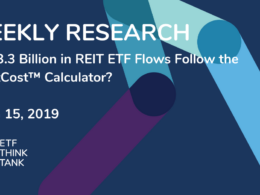In the last research note, we considered recent market volatility and analyzed low-vol ETFs.
This week, we share our research on the growth of the ETF industry including our usual key performance indicators (KPIs) on number of ETFs listed, assets, revenue, exchange market share and number of issuers. In this halftime report, we cover the state of the ETF industry in 2019 by reviewing how these KPIs have changed through June 30, 2019.

New Listings Grow Faster than Closings
There are currently 2,282 ETFs listed in the U.S. Over the last 12 months, we have seen 264 new ETFs launch compared with 169 ETFs that closed, for a 1.51 open-to-close ratio. However, the ratio is showing improvement. We have witnessed the ratio improving to 1.75 for the first six months of 2019, or 1.75 new ETFs for each closed ETF. This KPI shows an increasing appetite for issuers to continue to launch new and creative ETF ideas.

Assets Grow While Influence Diversifies
As of June 30, 2019, U.S. ETF assets were $3.98 trillion, an all-time high. That’s an increase of about 18% year to date. Another KPI of significance is the “ownership influence score.”
Our average ETF ownership influence has dropped this year, from 8.25% at the beginning of 2019 to 6.90%, due to a more diversified offering and a concentration of ETF flows toward large cap U.S. equities. The ownership influence score is the average amount of the market cap of every U.S. stock owned by ETFs.
For example, below we show how our Ownership Influence Tool in the ETF Think Tank App calculates that 5.6% of Apple (“AAPL”) is owned by ETFs versus an average of 6.9% for most U.S. stocks, helping investors to see that ETFs are “under-influencing” the movements of this particular stock.
Or, maybe better said, stocks behave more closely to their own fundamentals, and not ETF influence.

Revenue Grows While Fees Continue to Decline
The average weighted expense ratio for U.S. ETFs has dropped this from 0.20% to 0.19%. However, due to increased assets, the projected 12-month revenue from expense ratios has increased from $6.83 billion in January to $7.63 billion today.
The revenue also continues to diversify away from low cost, traditional beta and toward nontraditional passive “smart beta” ETFs and active ETFs.
The percentage of ETF revenue from nontraditional passive ETFs in January was 36.38%; today it’s 39.26%. Active ETF revenue also gained market share, growing from 5.11% to 5.42%. These KPIs help show that investors are still looking for interesting and creative strategies to help diversify their portfolio.

Exchange Market Share Remains Constant
Exchange market share of ETF listings has remained constant in 2019, with NYSE in a dominant position. Cboe Global Markets took share away from Nasdaq, increasing from 13.26% of listings to 14.11%, while Nasdaq decreased from 16.68% to 16.08%.

Growth in Issuers Continues
The number of branded issuers continues growing this year, from 133 to 144 as of June 30, 2019. That’s an 8.2% increase, and consistent with the number of new asset managers embracing the superior structure of the ETF wrapper.
That said, the chart below from Morningstar Research shows assets remain concentrated with the top three issuers. It appears that, for the most part, Vanguard’s market expansion is coming at the expense of State Street and iShares, and not from other ETF issuers.

TETF.Index Performance

Returns as of July 9, 2019.
Inception Date: April 4, 2017.
Index performance is for informational purposes only and does not represent the ETF. Indexes are unmanaged and one cannot invest directly in an index. Past performance is NOT indicative of future results, which can vary.
TETF.Index Performance vs. Leading Financial Indexes

Click here for information on the Index following the ETF industry
Follow us on Twitter @ETFThinkTank
Follow us on LinkedIn












